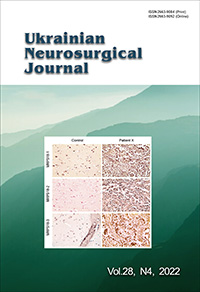Features of neuro-ophthalmic symptoms in patients with parasellar meningiomas
DOI:
https://doi.org/10.25305/unj.262508Keywords:
parasellar meningiomas, compression optic neuropathy, optic nerve atrophyAbstract
Goal. To analyze the features of neuro-ophthalmic symptoms and study visual functions recovery following parasellar meningiomas (PM) surgery.
Material and methods. We have analyzed the results of treating 47 patients with PM which have been operated in the Romodanov Neurosurgery Institute in 2017 - 2021. The main group included 47 patients (94 eyes) with PM with visual disorders. Clinical-neurological and ophthalmological examination and a range of neuroimaging studies were carried out. To evaluate the visual functions, the results were analyzed according to the recommendations of the German Ophthalmological Society.
Results. Binocular visual disturbances have been detected in 34 (72.3%) patients. Among visual field defects, absolute bitemporal hemianopia prevailed in 14.9% of patients and a combination of relative upper quadrant temporal hemianopia with absolute temporal hemianopia in 19.2% of patients. Monocular visual disturbances have been detected in 13 (27.7%) patients. Optic nerve atrophy was found in 38 patients (80.9%): unilateral - 21 patients (21 eyes), bilateral - 17 patients (34 eyes). A probable difference was revealed in the average visual acuity: before treatment 0.55±0.04, after treatment 0.67±0.04 (p<0.05) and the average total loss of sensitivity: before treatment 11.37±0, 78 dB and after treatment 9.14±0.79 dB (p<0.05).
Conclusions. Parasellar meningiomas constitute a significant part of extracerebral tumors. As a result of surgical treatment, there is a significant improvement in visual acuity and visual field.
References
Amirjamshidi A, Mortazavi SA, Shirani M, Saeedinia S, Hanif H. ‘Coexisting pituitary adenoma and suprasellar meningioma-a coincidence or causation effect: report of two cases and review of the literature’. J Surg Case Rep. 2017 May 22;2017(5):rjx039. doi: 10.1093/jscr/rjx039
Valassi E, Biller BM, Klibanski A, Swearingen B. Clinical features of nonpituitary sellar lesions in a large surgical series. Clin Endocrinol (Oxf). 2010 Dec;73(6):798-807. doi: 10.1111/j.1365-2265.2010.03881.x
Ajlan AM, Choudhri O, Hwang P, Harsh G. Meningiomas of the tuberculum and diaphragma sellae. J Neurol Surg B Skull Base. 2015 Feb;76(1):74-9. doi: 10.1055/s-0034-1390400
Gatto F, Perez-Rivas LG, Olarescu NC, Khandeva P, Chachlaki K, Trivellin G, Gahete MD, Cuny T; on behalf of the ENEA Young Researchers Committee (EYRC). Diagnosis and Treatment of Parasellar Lesions. Neuroendocrinology. 2020;110(9-10):728-739. doi: 10.1159/000506905
Mariniello G, Bonavolontà G, Tranfa F, Maiuri F. Management of the optic canal invasion and visual outcome in spheno-orbital meningiomas. Clin Neurol Neurosurg. 2013 Sep;115(9):1615-20. doi: 10.1016/j.clineuro.2013.02.012
Perondi GE, Isolan GR, de Aguiar PH, Stefani MA, Falcetta EF. Endoscopic anatomy of sellar region. Pituitary. 2013 Jun;16(2):251-9. doi: 10.1007/s11102-012-0413-9
Fahlbusch R, Schott W. Pterional surgery of meningiomas of the tuberculum sellae and planum sphenoidale: surgical results with special consideration of ophthalmological and endocrinological outcomes. J Neurosurg. 2002 Feb;96(2):235-43. doi: 10.3171/jns.2002.96.2.0235
Palani A, Panigrahi MK, Purohit AK. Tuberculum sellae meningiomas: A series of 41 cases; surgical and ophthalmological outcomes with proposal of a new prognostic scoring system. J Neurosci Rural Pract. 2012 Sep;3(3):286-93. doi: 10.4103/0976-3147.102608
Graillon T, Regis J, Barlier A, Brue T, Dufour H, Buchfelder M. Parasellar Meningiomas. Neuroendocrinology. 2020;110(9-10):780-796. doi: 10.1159/000509090
Matoušek P, Cvek J, Čábalová L, Misiorzová E, Krejčí O, Lipina R, Krejčí T. Does Endoscopic Transnasal Optic Nerve Decompression Followed by Radiosurgery Improve Outcomes in the Treatment of Parasellar Meningiomas? Medicina (Kaunas). 2022 Aug 22;58(8):1137. doi: 10.3390/medicina58081137
Goel A, Muzumdar D, Desai KI. Tuberculum sellae meningioma: a report on management on the basis of a surgical experience with 70 patients. Neurosurgery. 2002 Dec;51(6):1358-63; discussion 1363-4
Yasargil M.G. Microneurosurgery: Principles, Applications, and Training. In: Sindou M., editor. Practical Handbook of Neurosurgery. Springer-Verlag Vienna, 2009. doi: 10.1007/978-3-211-84820-3
Ohta K, Yasuo K, Morikawa M, Nagashima T, Tamaki N. Treatment of tuberculum sellae meningiomas:a long-term follow-up study. J Clin Neurosci. 2001 May;8 Suppl 1:26-31. doi: 10.1054/jocn.2001.0873
Downloads
Published
How to Cite
Issue
Section
License
Copyright (c) 2023 Ekaterina S. Egorova, Mykola O. Guk, Valeriia V. Musulevska

This work is licensed under a Creative Commons Attribution 4.0 International License.
Ukrainian Neurosurgical Journal abides by the CREATIVE COMMONS copyright rights and permissions for open access journals.
Authors, who are published in this Journal, agree to the following conditions:
1. The authors reserve the right to authorship of the work and pass the first publication right of this work to the Journal under the terms of Creative Commons Attribution License, which allows others to freely distribute the published research with the obligatory reference to the authors of the original work and the first publication of the work in this Journal.
2. The authors have the right to conclude separate supplement agreements that relate to non-exclusive work distribution in the form of which it has been published by the Journal (for example, to upload the work to the online storage of the Journal or publish it as part of a monograph), provided that the reference to the first publication of the work in this Journal is included.









